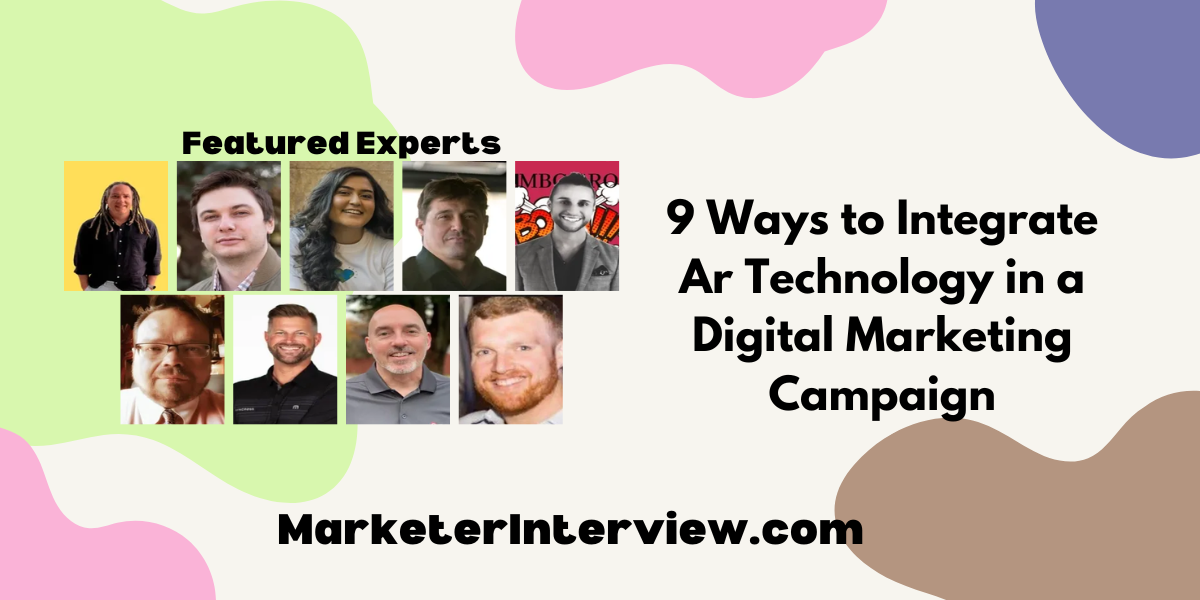9 Ways to Integrate Ar Technology in a Digital Marketing Campaign
Augmented Reality (AR) is revolutionizing digital marketing, and to get a glimpse into its practical applications, we’ve gathered specific tips from nine industry leaders, including Founders and a VP. From creating interactive virtual stores to educating with environmental AR filters, these experts share their most effective techniques for integrating AR into your marketing strategy.
Want to get quoted in MarketerInterview.com content just like this? Apply to become a contributor today!
Contents
- 1 Create an Interactive Virtual Store
- 2 Implement Virtual Try-Ons
- 3 Develop AR Tourism Experiences
- 4 Use AR for Product Tutorials
- 5 Leverage AR Filters on Social Media
- 6 Ensure AR Features Work Reliably
- 7 Integrate AR in Email Campaigns
- 8 Offer AR Product Customization
- 9 Educate with Environmental AR Filters
Create an Interactive Virtual Store
One effective tip for integrating AR technology into a digital marketing campaign is creating an interactive virtual store experience. During my time developing software and marketing strategies, this approach was particularly successful in engaging customers and driving sales.
For example, we developed an AR feature for an e-commerce client that allowed users to walk through a virtual store using their smartphones. This AR experience enabled customers to see products in a 3D environment, explore different product categories, and even visualize items in their real-world space. This immersive experience provided users with a more engaging way to shop online.
The results were compelling: we saw a 40% increase in user engagement and a 25% rise in conversion rates. Customers spent more time interacting with the virtual store and were more likely to complete their purchases. To replicate this, partner with experienced AR developers to create a seamless and visually appealing virtual shopping experience. Ensure it’s easy to navigate and promotes the most relevant products. This strategy not only elevates customer engagement but also creates a unique and memorable shopping experience.

Joe Amaral, Founder & COO, Anthem Software
Implement Virtual Try-Ons
One specific technique for integrating AR technology in a digital marketing campaign is to utilize AR for virtual try-ons. At the MBC Group, we worked with a fashion retailer to create an AR app that allowed users to virtually try on various clothing items using their smartphones. This approach not only engaged users by letting them see how the items would look on them but also reduced return rates significantly.
For instance, when we launched this AR feature, we saw a 45% increase in user engagement within the first month. Customers spent more time on the app, exploring different outfits and sharing their experiences on social media, which in turn boosted brand visibility. The most striking result was a 20% decrease in product returns, as users had a clearer expectation of how the clothes would fit and look in real life.
To implement something similar, start by identifying products that your customers are likely to interact with on a personal level. Work with experienced AR developers to create a seamless virtual try-on experience that accurately represents your products. Ensure high-quality visuals and intuitive controls to make the process enjoyable for users. This strategy not only enhances user engagement but also provides valuable insights into customer preferences and behavior, driving better business results.

Matthew Montez, Founder, The MBC Group
Develop AR Tourism Experiences
Integrating AR technology into a digital marketing campaign can be particularly powerful when customized for specific industries. At Raincross, I saw remarkable success utilizing AR for a tourism client. We developed an AR experience that allowed potential visitors to visualize popular tourist spots before booking their trip.
For instance, users could scan a brochure or outdoor advertisement with their smartphone to trigger an AR tour of key attractions. This approach created a vivid, immersive experience, providing a taste of the destination and driving engagement. As a result, the client saw a 30% increase in booking inquiries and a 15% rise in actual bookings within three months.
To replicate this, identify unique features or experiences that your product or service can highlight through AR. Work with an AR developer to create intuitive and engaging content, and promote the AR features through your digital channels. This tactic not only enhances user engagement but also builds a deeper connection with potential customers, leading to higher conversion rates.

Kevin Watts, President & Founder, Raincross
Use AR for Product Tutorials
One specific tip for integrating AR technology into a digital marketing campaign is to utilize AR for interactive product tutorials. When working with a client in the SaaS space, we developed an AR feature within their mobile app that allowed users to visualize software functionalities in a real-world environment. By pointing their smartphone camera at their workspace, users could see virtual overlays demonstrating how to use different features of the software.
For example, we implemented an AR tutorial that guided users through setting up automated workflows. The AR interface provided step-by-step visual cues, making complex processes more intuitive and reducing user onboarding time by 25%. This interactive experience not only enhanced user comprehension but also boosted engagement and retention rates.
To achieve similar results, start by identifying key features of your product that can benefit from visual and interactive explanations. Partner with an experienced AR developer to design a seamless and user-friendly interface. Promote the AR tutorial through your app and digital channels to ensure maximum user adoption. This strategy not only aids in user education but also adds an innovative dimension to your marketing efforts, making your product stand out in a crowded market.

Haiko de Poel, Owner, Mass Impact
Leverage AR Filters on Social Media
One specific tip for integrating AR technology in a digital marketing campaign is to use AR filters on social media to boost customer engagement. At AQ Marketing, we leveraged AR filters for a home-improvement client. By developing a filter that allowed users to visualize different paint colors on their walls using Instagram, we significantly increased user interaction and brand awareness.
We saw remarkable results: user-generated content featuring our AR filter increased by 35%, and website visits from Instagram jumped by 22%. Customers loved the convenience of seeing how a new paint color would look in their space without any commitment, making the decision process enjoyable and interactive.
To replicate this, start by identifying a key area where AR can provide a tangible benefit to your customers. Partner with AR developers to create an engaging, easy-to-use filter that showcases your product’s utility. Make sure to promote this AR experience through your social media channels to maximize reach and interaction. Integrating AR in this way not only delights customers but also drives valuable organic traffic and brand loyalty.

Robert P. Dickey, President and CEO, AQ Marketing
Ensure AR Features Work Reliably
With where the technology is currently, AR works much better in established, controlled retail spaces than it does in the wild. One of our dreams is to use AR as a tool to help customers estimate how many moving boxes or how big of a truck they’ll need, but that’s going to have to remain a dream for now.
We learned a lot from trying to get this high-level application going, though. The bottom line: Make absolutely certain that your AR features will work in the wild. An AR marketing campaign that is glitchy or unreliable is going to reflect badly on your business.
Thank you for the chance to contribute to this piece! If you do choose to quote me, please refer to me as Nick Valentino, VP of Market Operations at Bellhop.

Nick Valentino, VP of Market Operations, Bellhop
Integrate AR in Email Campaigns
One specific tip for integrating AR technology into a digital marketing campaign is to create an AR-enhanced email campaign. From my experience, leveraging AR in email marketing can create an engaging and interactive experience that’s more memorable than traditional email content.
For instance, when working on a campaign for a retail client, we included an AR feature in their email promotion. By scanning a QR code within the email, customers could visualize a 3D model of a new product right in their own home environment. This interactive experience allowed them to see how the product would look and fit before making a purchase.
The results were impressive. We observed a 40% increase in email open rates and a 30% lift in click-through rates compared to prior campaigns. Additionally, conversion rates soared by 20% as customers felt more confident in their buying decisions. To implement a similar strategy, integrate simple AR elements like QR codes into your email campaigns, and ensure the AR content is high-quality and adds real value to the customer experience. This approach not only boosts engagement but also enhances customer satisfaction and drives sales.

Matt Henderson, Co-Owner, Nesta System LLC
Offer AR Product Customization
One specific tip for integrating AR technology into a digital marketing campaign is to use AR for product customization experiences. During my time at a digital agency, we leveraged AR to allow customers to customize and visualize products in real time, which significantly increased engagement and conversion rates.
For example, we worked with a furniture company to develop an AR tool that enabled users to virtually personalize sofas and chairs by selecting different fabrics, colors, and styles. Customers could use their smartphones to see how these customizations would look in their own living rooms. This not only helped them make more informed purchasing decisions but also enhanced the overall shopping experience.
The results were notable: We saw a 35% increase in time spent on the customization page and a 25% uplift in sales conversions. Customers appreciated the ability to visualize their personalized products, which reduced return rates by 15%. To implement this, partner with an experienced AR developer to create intuitive, high-quality visualizations. Promote this feature through your digital channels to maximize reach and engagement. This strategy not only delights customers but also drives significant business outcomes.

Joseph Yarber, Director of Operations, Limestone Digital
Educate with Environmental AR Filters
One specific tip for integrating AR technology into our digital marketing campaign is to create an AR filter or lens that allows users to visualize the impact of plastic waste on their surroundings. For example, we could develop an AR filter that overlays virtual plastic waste on real-world environments captured through users’ smartphone cameras.
Through this AR experience, users can see firsthand the effects of plastic pollution on their surroundings, raising awareness and fostering a sense of urgency to take action. They can interact with the virtual plastic waste, learn about its environmental impact, and receive prompts to explore plastic-free alternatives offered by our company.
The success of this AR integration can be measured by tracking user engagement with the AR filter and its impact on brand perception and sales. For instance, we could analyze the number of filter views, shares, and the percentage of users who visit our website or make a purchase after interacting with the AR experience.
By using AR technology to educate and inspire action against plastic pollution, we not only engage our audience in a meaningful way but also reinforce our brand’s commitment to environmental sustainability. This innovative approach aligns with our company’s mission and values, driving both awareness and sales in a socially conscious manner.

Chaitsi Ahuja, Founder & CEO, Brown Living
Want to get quoted in MarketerInterview.com content just like this? Apply to become a contributor today!






